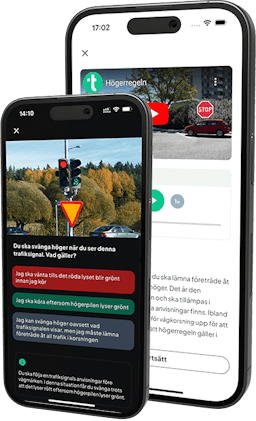The purpose of location signs is to help you navigate the roads and find the way to your destination. Direction signs can also provide information about facilities along the way or road type. In this guide, we will go through some of the most common location signs.
Location signs which indicate direction
Direction signs indicate what destination certain roads, turns and exit lanes lead to.
This direction sign (A) is used at junctions. It indicates that you should continue straight ahead at the junction if you want to go to Falun or turn to the right if you want to go to Lindesberg.
At roundabouts, you will find this direction sign (B) which shows which exit leads to which destination.
Direction sign (C) can be found at junctions where left turns are not permitted. To take a left turn, you will first need to come off to the right and then cross back over the road. This is called the Spanish turn.

Direction sign (A). This sign is used before junctions or roundabouts to help you prepare and get in lane for your destination. The bottom panel indicates the remaining distance to the junction or the roundabout.
Before exit lanes, this road sign (B) lets you know the distance to the exit and where it goes.
Road sign (C) can be found where the exit lane begins.

At junctions, you will sometimes find direction signs (A) which indicate where the road you are turning onto goes. The colour of the sign tells you what type of road you are turning onto. If the sign is blue with white letters, then this means that the road is a public road. If there are numbers on the sign (B), these indicate the distance to the destination in kilometres.
If the sign is green with white letters (C), this means that the road is a motorway or a clearway.

A yellow and red sign with black letters (A) indicates a private road.
A white sign with black letters (B) indicates a local destination such as a neighbourhood.
A white sign with black letters (C) can also be used to indicate a local establishment such as a police station or the tourist office.

A brown sign with white letters (A) is used to indicate the way to a tourist destination.
An orange sign with black letters (B) is a temporary directional sign which is used in the case of roadworks, for example.
A yellow sign with green text (C) is used at events such as concerts, for example.

When driving on roads with several lanes (such as a motorway), you will find lane signs (A) which indicate where each lane goes. Lane signs are displayed above the lane that they concern.
Road sign (B) indicates the route number.

There are also certain location signs which provide information about the lane.
Number of lanes increases (A).
Number of lanes decreases (B). Whenever two lanes merge into one, road users in both lanes must pay mutual consideration to one another; i.e. nobody has a specific duty to give way.
Road connection with acceleration lane (C).

Road connection with separate lane (A).
Diversion route (B). This road sign is used if a road is temporarily closed as a result of roadworks, for example.
Road sign (C) indicates the direction of travel for diverted traffic.

Junction number (A). This sign indicates the number of a junction.
Direction of travel for hazardous goods (B).

Location signs providing information
Location signs can also provide information about public facilities and services.
Examples of common information signs:
- Hospital with emergency department (A)
- Industrial area (B)
- Airport (C)
- Fuel (D). For example, a petrol station.

- Hotel (A)
- Picnic area (B)
- World heritage site (C). Signs which are brown in colour indicate a tourist attraction.



